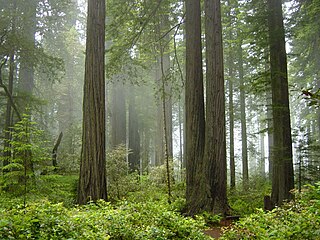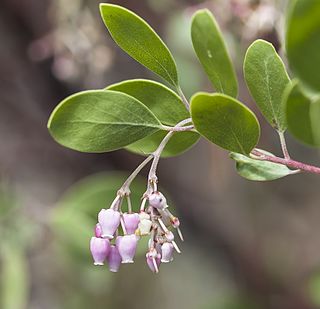
Arctostaphylos is a genus of plants comprising the manzanitas and bearberries. There are about 60 species of Arctostaphylos, ranging from ground-hugging arctic, coastal, and mountain shrub to small trees up to 6 m tall. Most are evergreen, with small oval leaves 1–7 cm long, arranged spirally on the stems. The flowers are bell-shaped, white or pale pink, and borne in small clusters of 2–20 together; flowering is in the spring. The fruit are small berries, ripening in the summer or autumn. The berries of some species are edible.

The Northern California coastal forests are a temperate coniferous forests ecoregion of coastal Northern California and southwestern Oregon.

Arctostaphylos tomentosa is a species of manzanita known by the common name woollyleaf manzanita or woolley manzanita. This shrub is endemic to California.

Arctostaphylos glandulosa, with the common name Eastwood's manzanita, is a species of manzanita.

Arctostaphylos pallida, commonly known as pallid manzanita, Oakland Hills manzanita, and Alameda manzanita, is an upright manzanita shrub from the Ericaceae, or heath family. It is endemic to the eastern San Francisco Bay Area of Northern California.

Arctostaphylos nummularia is a species of manzanita known by the common names glossyleaf manzanita, dwarf manzanita and Fort Bragg manzanita. It is endemic to California, where it grows in the forests of the coastal and inland ranges north of the San Francisco Bay.

Arctostaphylos densiflora, known by the common name Vine Hill manzanita, is a very rare species of manzanita. It is endemic to Sonoma County, California, where it is known from only one extant population of 20 to 30 individual plants. These last wild members of the species are on land near Sebastopol which is owned and protected by the California Native Plant Society. In addition, there are five to ten plants of this manzanita taxon growing on private property about a mile away. The local habitat is mostly chaparral on sandy shale soils.
Arctostaphylos glandulosa subsp. gabrielensis, known by the common name San Gabriel manzanita, is a subspecies of manzanita. It is endemic to one small area in the San Gabriel Mountains of Los Angeles County, California.

Arctostaphylos myrtifolia is a rare species of manzanita known by the common name Ione manzanita. It is endemic to the Sierra Nevada foothills of California. It grows in the chaparral and woodland plant community on a distinctive acidic soil series, an oxisol of the Eocene-era Ione Formation, in western Amador and northern Calaveras counties. There are only eleven occurrences, of which three have not been recorded since 1976. This is a federally listed threatened species.

Arctostaphylos nissenana is a species of manzanita known by the common name Nissenana manzanita or El Dorado manzanita. It is endemic to California, where it grows in the woodlands and chaparral of the Sierra Nevada foothills, mostly in El Dorado County.

Arctostaphylos obispoensis is a species of manzanita, known by the common names bishop manzanita and serpentine manzanita, endemic to California.

Arctostaphylos pechoensis is a species of manzanita known by the common name Pecho manzanita. It is endemic to California, where it is known only from the Pecho Hills southwest of San Luis Obispo in San Luis Obispo County, California.

Arctostaphylos regismontana is a species of manzanita known by the common name Kings Mountain manzanita. It is endemic to California, where it is known from the northern slopes of the Santa Cruz Mountains in the southern San Francisco Bay Area.

Arctostaphylos virgata is a species of manzanita known by the common names Bolinas manzanita and Marin manzanita.

Arctostaphylos manzanita subsp. elegans, also known as the Konocti manzanita, is a subspecies of the Common manzanita. It is endemic to California. It was originally described at the rank of species as Arctostaphylos elegans in 1893 by Willis Linn Jepson. It was reduced to a subspecies of Arctostaphylos manzanita by Philipp Vincent Wells in 1968.

Arctostaphylos glandulosa subsp. crassifolia is a rare perennial shrub, a subspecies of manzanita within the heather family commonly known as the Del Mar manzanita. It is narrowly endemic to the sandstone coastal terraces of San Diego County and northwestern Baja California. It is a burl-forming evergreen shrub typically found growing in a rambling habit on poor soils and hardpan. From December to February, white to pink urn-shaped flowers decorate its foliage, giving way to small fruits. It is listed as endangered and is threatened by land development, invasive species and modifications to the natural fire regime.
Arctostaphylos bolensis is a species of perennial shrub in the heather family commonly known as the Cerro Bola manzanita. This species of manzanita is characterized by an erect habit, pendent panicles and the lack of a burl. It is a prolific bloomer, and when in blossom, it is enshrouded in white to pink urn-shaped flowers. This species is endemic to the Cerro Bola, and possibly the Cerro Italia, two mountain ranges southwest of the Valle de Las Palmas in northern Baja California.

Arctostaphylos montana is a species of manzanita. It is endemic to the San Francisco Bay area where it has been found on Mount Tamalpais and at the Presidio of San Francisco.
















